The best graphics cards under $400 on the market.
If you want to find the best graphics card under 400 dollars, this article is the most helpful assistant in the matter. The entries on the list below are the most efficient in their task of creating smooth and immersive visuals. Even with a limited budget, you can easily have a great gaming experience.
Under this price tag, you can find models capable of supporting ultra graphics settings at FHD resolution or even higher, with a high FPS count in addition. The search needs to be thorough to find such good deals, but you can skip that tedious process and make use of this list.
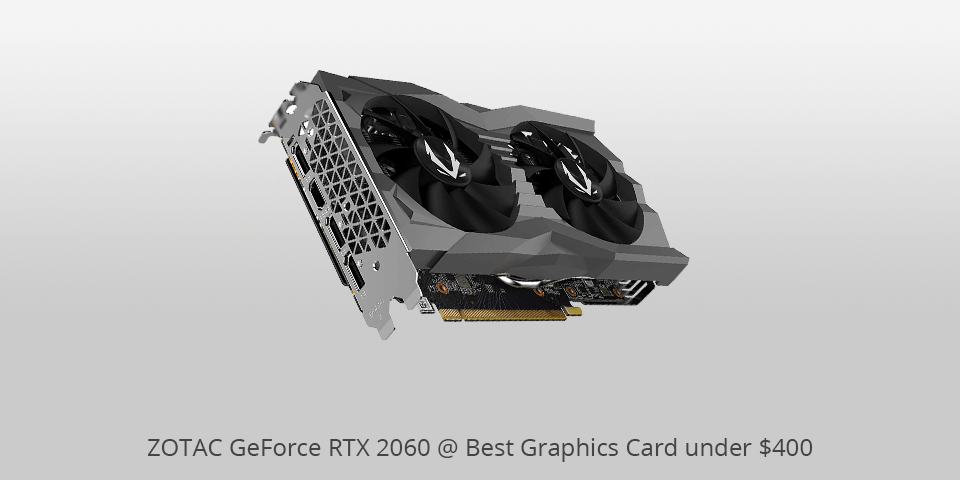
Stream Processors: 1920 CUDA Cores | Core Clock: 1365 MHz ( 1680 MHz boost) | Memory: 6 GB | Memory Clock: 14 Gbps | Power Connectors: 1 x 8-Pin | Outputs: 3 x DisplayPort 1.4, 1 x HDMI 2.0b
Quite possibly, it’s the absolute best graphics card under 400 dollars. Its powers are quite impressive and can even be compared to those of more expensive models. With the latest Turing architecture and Twin Fan arrangement, it can reproduce complicated visuals while maintaining reasonable temperatures.
As a gamer, you can expect real-time ray tracing and AI to perform at their best. Not only that, but the card can also work with VR applications and has some newer algorithms that make visuals look more impressive. It supports Variable Rate Shading, Multi-View Rendering and VRWorks Audio.
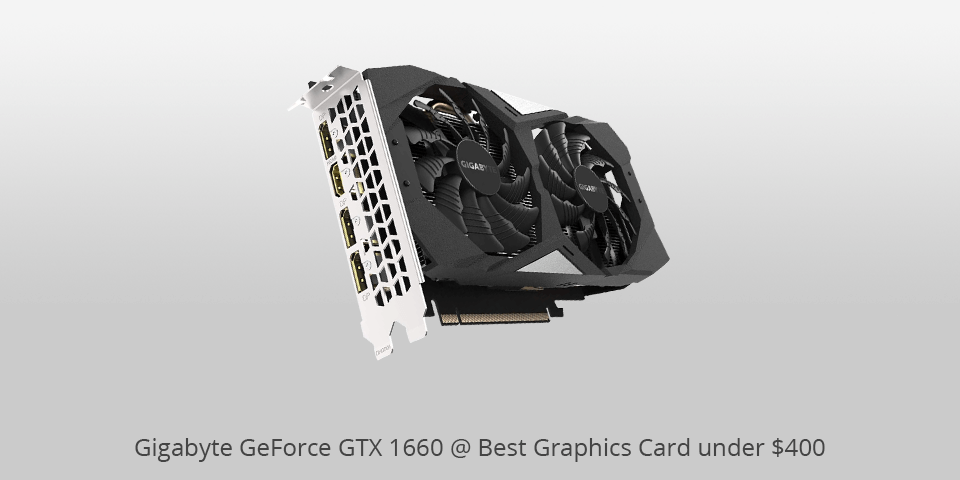
Stream Processors: Nvidia Turing TU116 | Core Clock: 1785 MHz ( 1830 MHz boost) | Memory: 6 GB | Memory Clock: 12 Gbps | Power Connectors: 1 x 8-Pin | Outputs: 1 x HDMI, 3 x DisplayPort
This particular model supplies you with an exquisite photo mode that can capture the finest details of your battle glory. Each shot will have the highest resolution with features like 360-degree, HDR and stereo support.
It is a mainstream card, but the visuals are as near outstanding as you can hope. The AAA titles can be enjoyed in FHD with a 60 FPS rate and higher still for some esports titles.
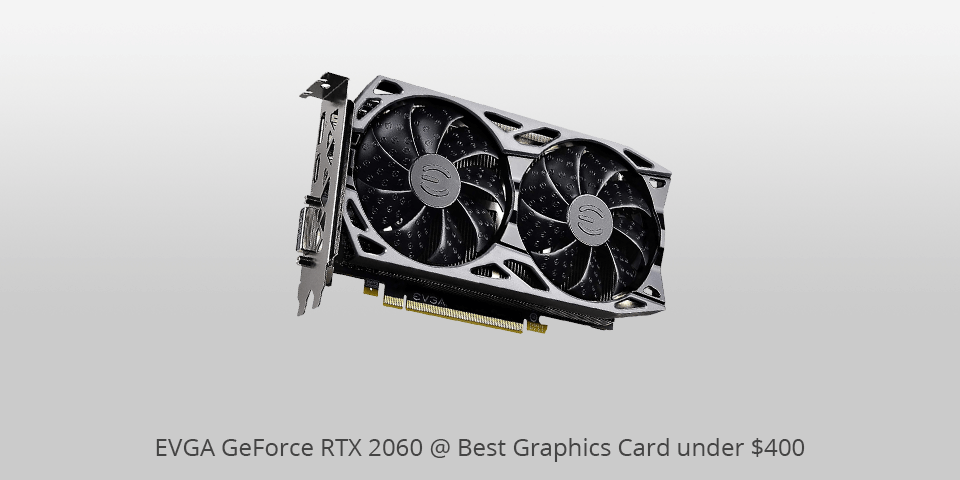
Stream Processors: 1920 | Core Clock: 1750 MHz ( 1755 MHz boost) | Memory: 6 GB | Memory Clock: 14 Gbps | Power Connectors: 1 x 8-Pin | Outputs: 3 DVI-D
It’s the best graphics card for under 400 dollars for those who want to enjoy high-res gaming. You can set all the highest preferences in your game with a 60 FPS FHD screen and a QHD one will require minor scaling down.
You can expect efficient processing, smooth and realistic visuals in any game. Among all the versions built on the 2060 core, this one is the most reasonably priced with only a high noise level as a negative consequence of that.
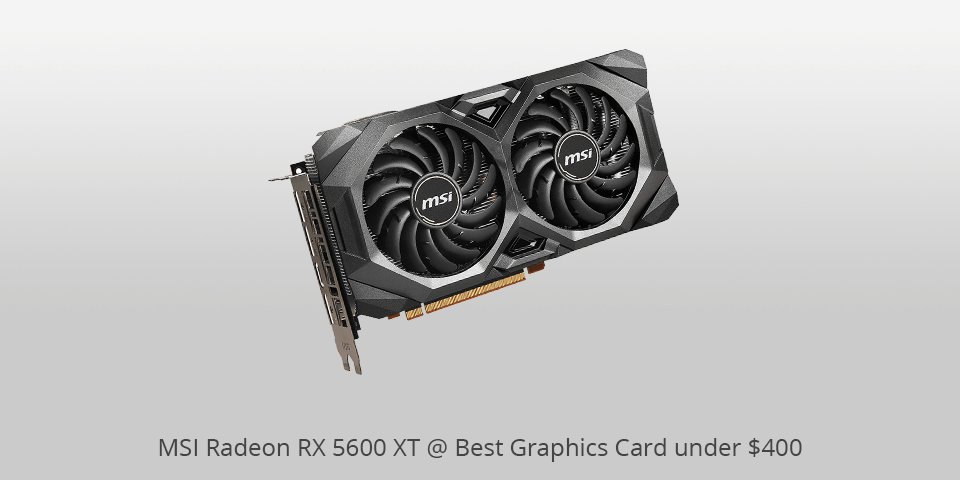
Stream Processors: 2304 | Core Clock: 1420 MHz ( 1600 MHz boost) | Memory: 6 GB | Memory Clock: 12 Gbps | Power Connectors: 8-Pin | Outputs: 3x DisplayPort / 1x HDMI 2.0b
This is a very solid option as well, with 7nm RDNA architecture and a supply of 6 GB of GDDR6 VRAM. You can easily play current games at Full HD and enjoy smooth and realistic visuals. The card keeps steady and cool while doing its best, the merit of the interesting fan design.
It has alternating traditional and dispersion blades that send focused and powerful airflow into the heatsink. The computational capacity is perfect for VR gameplay. The API support allows you to control the performance through your favorite program.
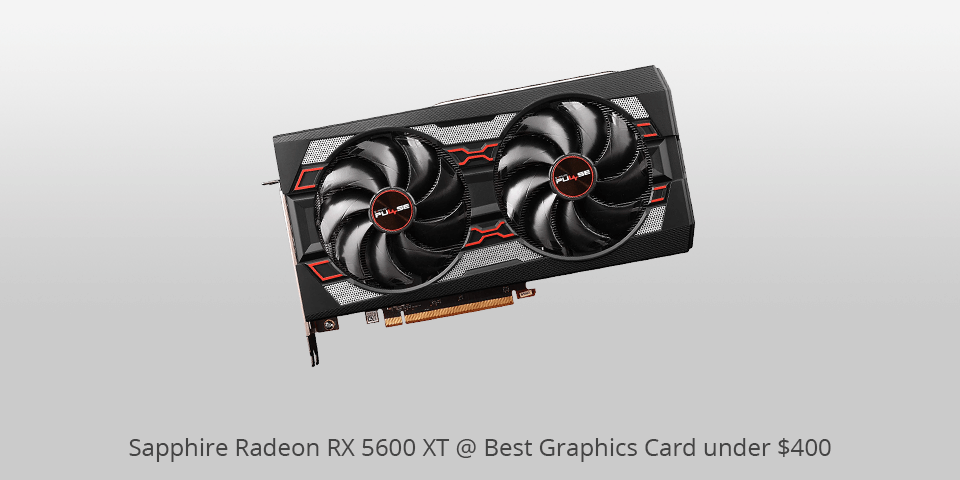
Stream Processors: AMD Radeon Navi | Core Clock: 1615 MHz ( 1750 MHz boost) | Memory: 192 bits | Memory Clock: 14 Gbps | Power Connectors: PCI | Outputs: 3 x DP, 1 x HDMI
Another candidate for the best 400 dollar GPU title that can put up a good fight. This GPU comes with 2304 processors supported by the latest RDNA architecture with a 7nm gate length. It can operate with the Game Clock of 1615 MHz or the Boost Clock reaching 1750 MHz.
Its capacity is enough to produce a 60 FPS rate when you are playing AAA games. While it can’t be considered flawless, the testing results are higher than the manufacturer’s estimations. In fact, the card can compete with some of the slightly more powered entries on this list.
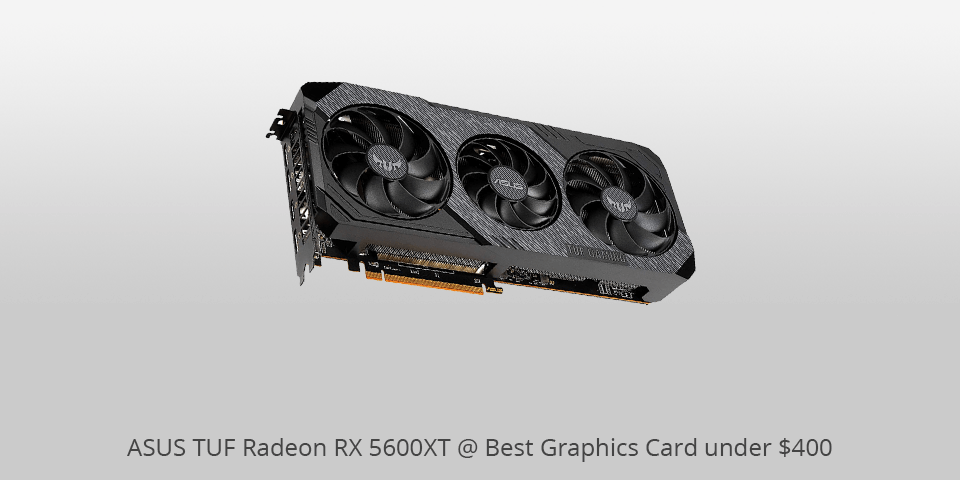
Stream Processors: 2304 | Core Clock: 1660 MHz ( 1615 MHz boost) | Memory: 6 GB | Memory Clock: 12 Gbps | Power Connectors: 1 x 8-Pin | Outputs: 3 x DisplayPort 1.4, 1 x HDMI 2.0b
This model is a good option if you’re building an AMD setup to enjoy FHD visuals when playing games. You’ll have 6 GB of GDDR6 VRAM. Combined with the 7nm RDNA architecture, it results in incredible smoothness of visuals. You can even expect good performance in the VR apps. What’s also great about the model is the cooling.
To start with, you get a set of two fans with elongated blades and a barrier ring that make less noise but cool more efficiently. In addition, they work only when the card heats to a certain temperature. This means that you can enjoy its quiet performance at all times except when the visuals are getting intense.
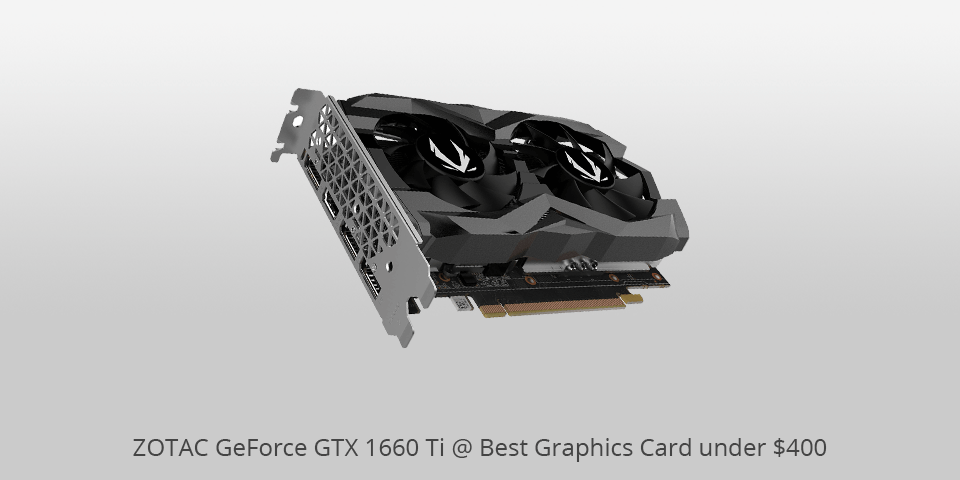
Stream Processors: 1536 CUDA Cores | Core Clock: 1770 MHz ( 1860 MHz boost) | Memory: 6 GB | Memory Clock: 12 Gbps | Power Connectors: 1 x 8-Pin | Outputs: 3 x DisplayPort 1.4, 1 x HDMI 2.0b
It’s another strong contestant for the name of the best graphics card under 400 dollars. The brand seems to be particularly fond of tuning up existing designs, and so this one is a “Super” version of a year-old model.
It does have the strongest Turing architecture and an incredibly fast GDDR6 memory unit. If you have an FHD monitor, this model will be enough to bring the visuals up to the standard.
| IMAGE | NAME | FEATURES | |
|---|---|---|---|

|
ZOTAC GeForce RTX 2060
Compact
|
CHECK PRICE → | |

|
EVGA GeForce RTX 2060
Easy to Install
|
CHECK PRICE → | |

|
Gigabyte GeForce GTX 1660
Our Choice
|
CHECK PRICE → |
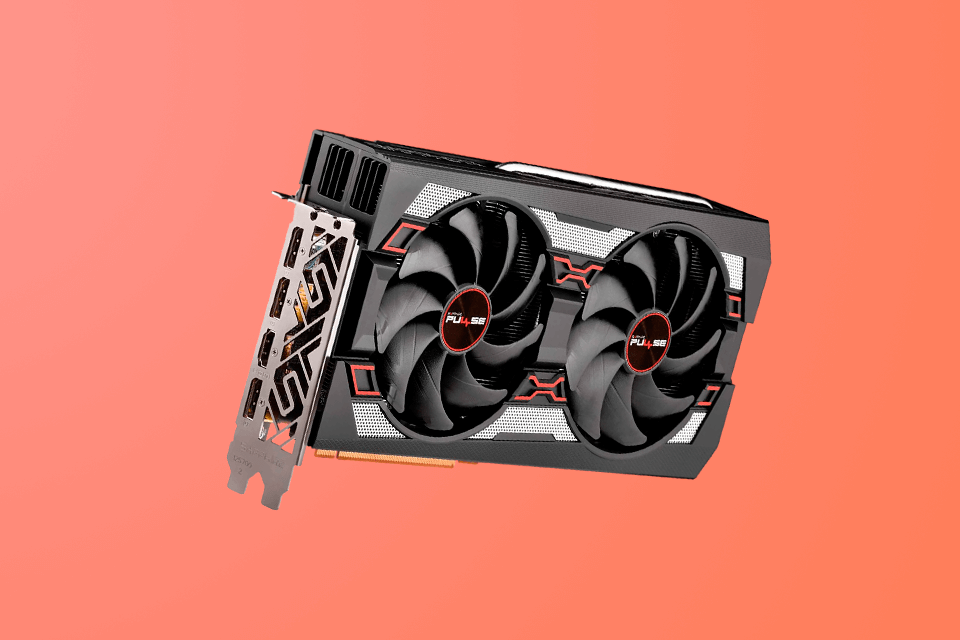
Assembling a new PC for gaming is an expensive matter. When it comes to such crucial components as the video card, it is extremely important to find a well-balanced deal. To begin with, prices for graphics cards are mostly stable and discounts are only introduced when the newer models are about to pop. Plus, if there is a sale of some decent model, it gets sold out almost immediately. You can hunt for such rare deals if you find it fun, but a more reasonable approach is to find a model that offers the most for the smallest price.
So, you made up your mind about the GPU model that you want to install only to discover that there are very different versions to be found on the market. The trick is that AMD and NVIDIA make the cards themselves, and then there are various intermediary brands that equip them with accessories. For example, NVIDIA recently manufactured one new GPU model, the GTX 1650. Soon enough, giants like Gigabyte and many other large and small companies issued their versions supplied with cooling, overclocking, illumination and similar bells and whistles, all in different configurations.
In this manner, the market is supplied with ample choice, but the process of selecting the best video graphics card for under 400 bucks is turned into endless hours of comparison. To make it easier, see below which of these add-ons are really important and how you should prioritize additional features.
If you research the market of assembled PCs, you will find that regular machines are built to rely heavily on the CPU and RAM combination. Unless the device is intended for gaming, you will find no graphics card in it as such. What they normally have is an integrated graphics-acceleration silicon unit that performs this role and brings the cost down significantly.
Integrated units work just fine for regular tasks and even some more visually-intense activities. Regular users and businessmen routinely rely on laptops and desktops with such a build and never know any trouble. However, they aren’t suitable for gamers and creative professionals since games and software operate using a dedicated graphics card.
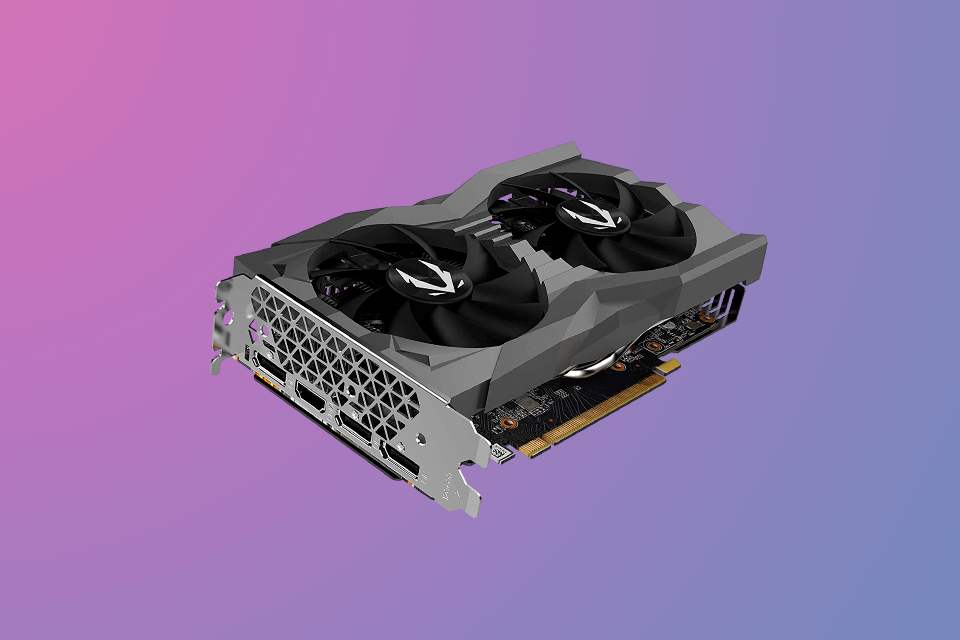
This value is basically the total pixel count of your entire screen that the graphics card will have to process. This number defines how powered a GPU needs to be and consequentially, how much you will need to spend. However, it will also depend on the intended use because dedicated GPUs are capable of generating 4K visuals for everyday purposes.
A satisfactory gamer’s experience requires much more from the hardware because here, a refresh rate is driven up significantly. Aside from that, the GPU makes other computations like the geometry and lighting of the scene, everything on the go and in real-time. The sharper you want to keep the details of your high-paced game, the more powerful a device you will need.
The RTX 2080 model is better all throughout. It is more recent, costs less and performs faster than the GTX 1080 Ti. The latter outperforms it in a few games but it doesn’t justify the difference in their prices.
This model can only be considered “future proof” at a stretch because the latest games are starting to tax it more and more. Something much better capable of standing the test of time will be the Radeon 5700XT model that costs about the same but performs on the level with the RTX 2070 Super instead.
For this year, the model is still considered quite potent and its capabilities are compared to those of the RTX 2070 Super. This GPU is now priced at about $500. You can say it loses 10% of its value per each following year of remaining on the market.
If you take the 2070 GPU, its Ray Tracing capabilities are somewhat lousy, especially compared to the 2080 Ti, but then there is the 2060 GPU that doesn’t support it at all. Technically, the RTXs are similar to the old 10xx series with the difference in their naming patterns only. However, this series of GPUs is entirely new, and that keeps its prices at a higher level.